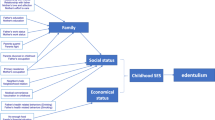Abstract
Complete edentulism is the terminal outcome of a multifactorial process involving biological factors and patient related factors. Tooth loss associated with periodontal disease and caries has an apparent impact on an individual’s quality of life, and has been associated with lower levels of satisfaction with life and a lower morale. The rate of total edentulism is said to be increasing in developing countries and this had been attributed mainly to the high prevalence of periodontal diseases and caries. The distribution and prevelance of complete edentulism between developed and less developed countries may be associated with a complex interrelationship between cultural, individual, attitude, behavior, dental attendance, etiopathogenesis of edentulism, access to care and socioeconomic factors. The purpose of this study was to assess the relationship between socio-demographic factors and edentulism. In order to plan for future oral health care provisions for the society, collecting epidemiological data on oral health particularly related to prosthodontics and its related issues are very important.


Similar content being viewed by others
References
Academy of Prosthodontics (2005) Glossary of prosthodontic terms. J Prosthet Dent 94:10–92
Petersen PE, Bourgeois D, Ogawa H et al (2005) The global burden of oral diseases and risks to oral health. Bull World Health Organ 83:661–669
World Health Organization (2003) The world oral health report 2003. WHO Press, Geneva
Marcenes W, Steele JG, Sheiham A, Walls AW (2003) The relationship between status, food selection, nutrient intake, nutritional status and body mass index in older people. Cad Saude Publica 19:809–816
Kalk W, Van Rossum GMJM, Van Waas MAJ (1990) Edentulism and preventive goals in the treatment of mutilate dentition. Int Dent J 40:267–274
Shah N, Prakash H, Sunderman KR (2004) Edentulism, denture wear and denture needs of Indian elderly: a community-based study. J Oral Rehabil 31:467–476
Bouma J (1984) On becoming edentulous. An investigation into the dental and behavior reason for full mouth extraction. Thesis Ryksuniversteit te Grmingh
Eklund SA, Burt BA (1994) Risk factor for total tooth loss in the United States: longitudinal analysis of national data. J Public Health Dent 51(1):5–14
Caplan DJ, Weintraub JA (1993) The oral health burden in the United States: a summary of recent epidemiologic studies. J Dent Educ 57(12):853–862
Brekhus PJ (1929) Dental disease and its relation to the loss of human teeth. JADA 16:2237–2247
MacGregor IDM (1972) Pattern of tooth loss in a selected population of Nigerians. Arch Oral Biol 17:1573–1582
Sharma R (2012) Kuppuswamy’s socioeconomic status scale: revision for 2011. Indian J Pediatr 79(7):961–962
Okoisor FE (1977) Tooth mortality: a clinical study of causes of loss. Niger Med J 7:77–81
Kaimenyi JT, Sachdera P, Patel S (1988) Causes of tooth mortality at the dental hospital unit of Kenyatta National Hospital of Nairobi, Kenya. J Odonto-stomatologie Tropicale 1:17–20
Hoover JN, McDermott RE (1989) Edentulousness in patients attending a university dental clinic. J Can Dent Assoc 55(2):139–140
Suominen-Taipale AL, Alanen P, Helenius H, Nordblad A, Uutla A (1999) Edentulism among finish adults of working age. Community Dent Oral Epidemiol 27(5):353–365
Slade GD, Locker D, Leake JL, Wu AS, Dunkley G (1990) The oral health status and treatment needs of adults aged 65+ living independently in Ottawa-Carleton. Can J Public Health 81:114–119
Adler N, Boyce T, Chesney MA et al (1999) Socio-economic status and health: the challenge of gradient. Health Hum Rights 3:181–201
Hunter JM, Arbona ST (1995) The tooth as a marker of developing world quality of life: a field study in Guatemala. Soc Sci Med 41(9):1217–1240
Dolan TA, Gilbert CH, Duncan RP (2001) Risk indicators of edentulism, partial both loss and prosthetic status among black and white middle-aged and older adults. Community Dent Oral Epidemiol 29:329–340
Gordon WT, Phil SJK (1998) The impact of the demographics of aging and the edentulous condition on dental care services. J Prosthet Dent 79:56–69
Author information
Authors and Affiliations
Corresponding author
Rights and permissions
About this article
Cite this article
Nagaraj, E., Mankani, N., Madalli, P. et al. Socioeconomic Factors and Complete Edentulism in North Karnataka Population. J Indian Prosthodont Soc 14, 24–28 (2014). https://doi.org/10.1007/s13191-012-0149-2
Received:
Accepted:
Published:
Issue Date:
DOI: https://doi.org/10.1007/s13191-012-0149-2




